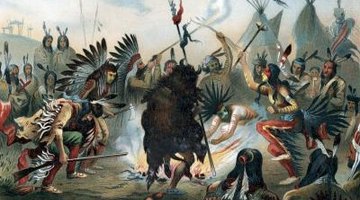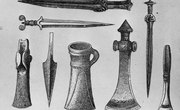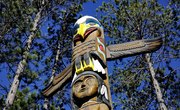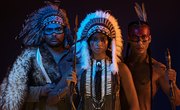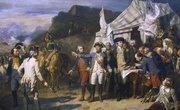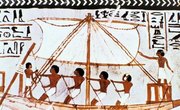Warriors were highly trained fighters who protected their villages and families. In some tribes, such as the Cherokees, both men and women could be warriors. Becoming a warrior involved tests of bravery, such as raiding an enemy encampment and returning with captives or stolen horses. During the United States expansion, warriors waged a formidable battle to retain possession of the land, but ultimately, Native Americans surrendered and signed treaties that fundamentally changed their way of life.
Courage and Honor
Accomplished warriors were highly respected and admired for their bravery. To earn the respect of their people, warriors had to be strong, determined and able to withstand pain. Even when tortured by an enemy, a warrior remained silent and stoic. It wasn’t necessary to kill an enemy to show bravery in Native American culture. In tribes such as the Lakota, warriors demonstrated courage by tapping an enemy in battle with an ornate object called a coup stick and escaping unharmed. This practice was called counting coup.
Adroit Fighting Skills
From an early age, aspiring warriors were mentally, spiritually and physically conditioned to track, hunt and fight. Warriors became experts in the use of lethal weapons, such as the bow and arrow, spears, knives, ball-headed clubs and tomahawks, which served them well in battle. Known for stealth tactics, warriors planned ambushes and raids of enemy supply wagons en route to military forts. Skilled leaders, like the famous Apache Geronimo and his 50 warriors, fought off the U.S. Army for years using shrewd strategies to defend their land and evade capture.
Hunger and Disease
Warriors grew weak and tired in their resistance efforts as their population plummeted due to hunger and disease. Lacking immunity to diseases introduced by Europeans, such as smallpox and measles, warriors risked contracting life-threatening diseases whenever they came into contact with American, French and British soldiers and traders. Warriors’ strength was sapped from famine brought about by military forces seizing Native American food supplies. Massive killing of bison when clearing the land for settlers further deprived warriors of a critical food source.
Political Infighting
Tribal rivalries prior to colonial settlement proved an insurmountable barrier for warriors hoping to unite against a common enemy. Distrust and disagreement over strategy undermined efforts to come together. Growing dependency on white traders for supplies also thwarted attempts to mount an organized campaign against the invading armies. For instance, Shawnee warrior Tecumseh tried to form a powerful confederation of different tribes. Tecumseh's efforts failed, largely due to certain tribes that didn't want to alienate the settlers and risk their supply of food, alcohol, guns and cookware.
Related Articles
References
- First People: The Legends
- National Museum of the American Indian: Native Words Native Warriors: Code Talking
- Google Books: European and Native American Warfare, 1675-1815, Chapter Eight
- National Wildlife Federation: Bison
- Ohio History Central: Techumseh's Confederacy
- Ohio History Central: Michikinikwa
- Native Languages of the Americas: Native American Indian Weapons
Resources
Writer Bio
Dr. Mary Dowd is a dean of students whose job includes student conduct, leading the behavioral consultation team, crisis response, retention and the working with the veterans resource center. She enjoys helping parents and students solve problems through advising, teaching and writing online articles that appear on many sites. Dr. Dowd also contributes to scholarly books and journal articles.

